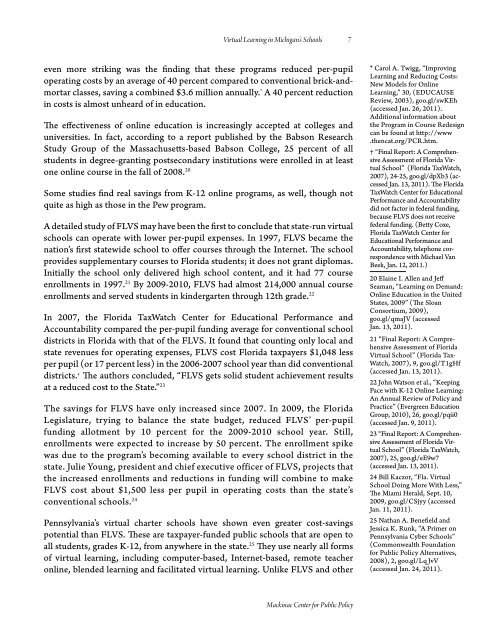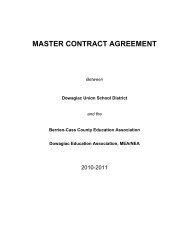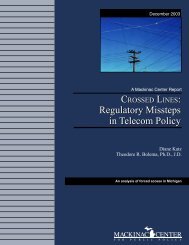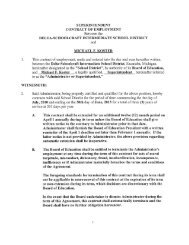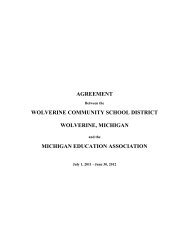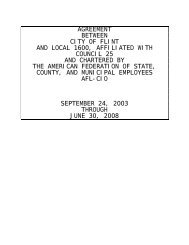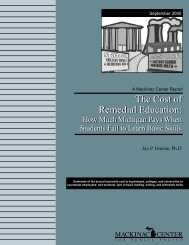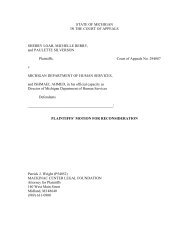by Michael Van Beek - Michigan Virtual University
by Michael Van Beek - Michigan Virtual University
by Michael Van Beek - Michigan Virtual University
Create successful ePaper yourself
Turn your PDF publications into a flip-book with our unique Google optimized e-Paper software.
<strong>Virtual</strong> Learning in <strong>Michigan</strong>’s Schools 7even more striking was the finding that these programs reduced per-pupiloperating costs <strong>by</strong> an average of 40 percent compared to conventional brick-andmortarclasses, saving a combined $3.6 million annually. * A 40 percent reductionin costs is almost unheard of in education.The effectiveness of online education is increasingly accepted at colleges anduniversities. In fact, according to a report published <strong>by</strong> the Babson ResearchStudy Group of the Massachusetts-based Babson College, 25 percent of allstudents in degree-granting postsecondary institutions were enrolled in at leastone online course in the fall of 2008. 20Some studies find real savings from K-12 online programs, as well, though notquite as high as those in the Pew program.A detailed study of FLVS may have been the first to conclude that state-run virtualschools can operate with lower per-pupil expenses. In 1997, FLVS became thenation’s first statewide school to offer courses through the Internet. The schoolprovides supplementary courses to Florida students; it does not grant diplomas.Initially the school only delivered high school content, and it had 77 courseenrollments in 1997. 21 By 2009-2010, FLVS had almost 214,000 annual courseenrollments and served students in kindergarten through 12th grade. 22In 2007, the Florida TaxWatch Center for Educational Performance andAccountability compared the per-pupil funding average for conventional schooldistricts in Florida with that of the FLVS. It found that counting only local andstate revenues for operating expenses, FLVS cost Florida taxpayers $1,048 lessper pupil (or 17 percent less) in the 2006-2007 school year than did conventionaldistricts. † The authors concluded, “FLVS gets solid student achievement resultsat a reduced cost to the State.” 23The savings for FLVS have only increased since 2007. In 2009, the FloridaLegislature, trying to balance the state budget, reduced FLVS’ per-pupilfunding allotment <strong>by</strong> 10 percent for the 2009-2010 school year. Still,enrollments were expected to increase <strong>by</strong> 50 percent. The enrollment spikewas due to the program’s becoming available to every school district in thestate. Julie Young, president and chief executive officer of FLVS, projects thatthe increased enrollments and reductions in funding will combine to makeFLVS cost about $1,500 less per pupil in operating costs than the state’sconventional schools. 24Pennsylvania’s virtual charter schools have shown even greater cost-savingspotential than FLVS. These are taxpayer-funded public schools that are open toall students, grades K-12, from anywhere in the state. 25 They use nearly all formsof virtual learning, including computer-based, Internet-based, remote teacheronline, blended learning and facilitated virtual learning. Unlike FLVS and other* Carol A. Twigg, “ImprovingLearning and Reducing Costs:New Models for OnlineLearning,” 30, (EDUCAUSEReview, 2003), goo.gl/swKEh(accessed Jan. 26, 2011).Additional information aboutthe Program in Course Redesigncan be found at http://www.thencat.org/PCR.htm.† “Final Report: A ComprehensiveAssessment of Florida <strong>Virtual</strong>School” (Florida TaxWatch,2007), 24-25, goo.gl/dpXb3 (accessedJan. 13, 2011). The FloridaTaxWatch Center for EducationalPerformance and Accountabilitydid not factor in federal funding,because FLVS does not receivefederal funding. (Betty Coxe,Florida TaxWatch Center forEducational Performance andAccountability, telephone correspondencewith <strong>Michael</strong> <strong>Van</strong><strong>Beek</strong>, Jan. 12, 2011.)20 Elaine I. Allen and JeffSeaman, “Learning on Demand:Online Education in the UnitedStates, 2009” (The SloanConsortium, 2009),goo.gl/qmaJV (accessedJan. 13, 2011).21 “Final Report: A ComprehensiveAssessment of Florida<strong>Virtual</strong> School” (Florida Tax-Watch, 2007), 9, goo.gl/T1gHf(accessed Jan. 13, 2011).22 John Watson et al., “KeepingPace with K-12 Online Learning:An Annual Review of Policy andPractice” (Evergreen EducationGroup, 2010), 26, goo.gl/pqii0(accessed Jan. 9, 2011).23 “Final Report: A ComprehensiveAssessment of Florida <strong>Virtual</strong>School” (Florida TaxWatch,2007), 25, goo.gl/eE9w7(accessed Jan. 13, 2011).24 Bill Kaczor, “Fla. <strong>Virtual</strong>School Doing More With Less,”The Miami Herald, Sept. 10,2009, goo.gl/CSjyy (accessedJan. 11, 2011).25 Nathan A. Benefield andJessica K. Runk, “A Primer onPennsylvania Cyber Schools”(Commonwealth Foundationfor Public Policy Alternatives,2008), 2, goo.gl/Lq JvV(accessed Jan. 24, 2011).Mackinac Center for Public Policy


